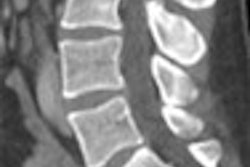Adopting PET/CT offers a host of clinical benefits, but successful practice requires awareness of key operational and legal factors, according to Dr. Todd Blodgett, an oncologic imaging fellow at the University of Pittsburgh Medical Center in Pennsylvania.
Blodgett spoke during a talk at the March PACS 2006: Digital Healthcare Information and Management Systems (DHIMS) conference in San Antonio, sponsored by the University of Rochester School of Medicine and Dentistry in New York.
For example, adoption of PET/CT can be controversial, owing to its requirement for expertise in radiology and nuclear medicine, Blodgett said. This can spark turf wars, with neither side wanting to lose procedures.
"When you have large institutions with a lot of (politics), you get a lot of controversy," he said.
PET/CT also comes with a number of critical training issues. The American College of Radiology (ACR) and the Society of Nuclear Medicine (SNM) have issued preliminary recommendations for PET/CT training, which provide guidelines depending on the physician's level of training (Journal of the American College of Radiology, July 2005, Vol. 2:7, pp. 568-584).
Among the recommendations: a nuclear medicine physician without any radiology training is supposed to read 150 PET/CT studies and 500 CT exams, and receive eight hours of PET/CT CME credit and 100 hours of CT CME credit. Radiologists with American Board of Radiology (ABR) and American Board of Nuclear Medicine (ABNM) certification, for example, are supposed to read 150 PET/CT studies and secure eight hours of PET/CT CME credit.
"Even though these (recommendations) are not enforced, in the future they probably will," Blodgett said.
CT protocols
With PET/CT, users need to be mindful of CT issues such as the quality of the scanner, number of detectors, quality of scan, contrast use, and protocols, Blodgett said.
In general there are three ways to utilize CT during PET/CT: a noncontrast CT for attenuation correction and localization, a noncontrast CT followed by PET and then contrast-enhanced CT, or an enhanced CT as part of the PET/CT, Blodgett said.
When some facilities perform a low-dose noncontrast CT for attenuation correction and localization purposes, they sometimes attach a disclaimer that says the images are not being interpreted and are "nondiagnostic," Blodgett said.
"If you do this, I recommend that you don't send it to your PACS system," Blodgett said. "Because if you have images there, somebody will be responsible for looking at those images."
Performing PET/CT with a single contrast-enhanced CT offers less radiation exposure to the patient than doing two CT scans, Blodgett said. Sites can charge for CT as usual. However, users must be aware of the pitfall of attenuation artifacts, he said.
Another approach, PET/CT with low-dose noncontrast CT and a full-dose contrast-enhanced CT, allows for use of low-dose CT for attenuation correction to avoid artifacts, but provides increased radiation dose to the patient, Blodgett said.
Legal issues
PET/CT produces some legal questions, Blodgett said. If a nuclear medicine physician reads a PET/CT study, does the CT need to be read, even if it's done for nondiagnostic purposes? And if the CT is not read, is a disclaimer sufficient to protect the nuclear medicine physician?
For example, a nuclear medicine physician might read a PET/CT and miss a non-FDG-avid tumor on the CT portion of the exam.
"Not all malignancies are very FDG-avid and have intense uptake," he said. "If you're a nuclear medicine physician, either hire a radiologist to look at the images, or get rid of these types of CTs, because you will miss it."
Other options could be having a nuclear medicine physician and a radiologist look at the images together or having a single dually trained physician reading all the images, Blodgett said.
Legally, there is no such thing as a nondiagnostic CT, low-dose or not, Blodgett said.
"If there is enough information on a CT to make a diagnosis, it's considered a diagnostic CT, even if you did it at 40 mAs and it looks like crap," Blodgett said. "If there is enough information on there to make a diagnosis, it's considered diagnostic, whether you put a disclaimer in there or not."
Workflow
Institutions adopting PET/CT need to sort through reporting and interpretation workflow issues, including deciding on a dual or single report, Blodgett said. A dual-report approach requires the development of a process to ensure that the reports correlate.
"You've got to have a mechanism whereby reports go out and actually correlate to what the findings are, both the PET and CT, and jibe with what the radiologist sees and what the nuclear medicine physician sees," he said.
Sites must also work through patient selection issues, deciding whether to do PET/CT on all patients, or if a PET scanner is also available, to just perform PET on certain patients. This could be decided by factors such as the type of malignancy, reason for request, a recent anatomical imaging study, and radiation treatment planning (RTP), according to Blodgett.
"One way to do it is any patients suspected of having active disease would be scanned on PET/CT," he said. "And any patient who came down for surveillance, (or) a trauma patient who's asymptomatic and you think has a low index of suspicion of active disease, could be scanned on the PET scanner."
By Erik L. Ridley
AuntMinnie.com staff writer
April 24, 2006
Related Reading
Limiting scan range cuts dose, boosts throughput in melanoma PET/CT, March 30, 2006
PET/CT shows slight edge over MRI in melanoma staging, March 8, 2006
PET/CT shows potential for detecting unknown primary cancers, December 8, 2005
PET/CT imaging useful in detecting and staging choroidal melanomas, November 8, 2005
Oncologic PET/CT: A primer for radiologists, October 14, 2005
Copyright © 2006 AuntMinnie.com




















